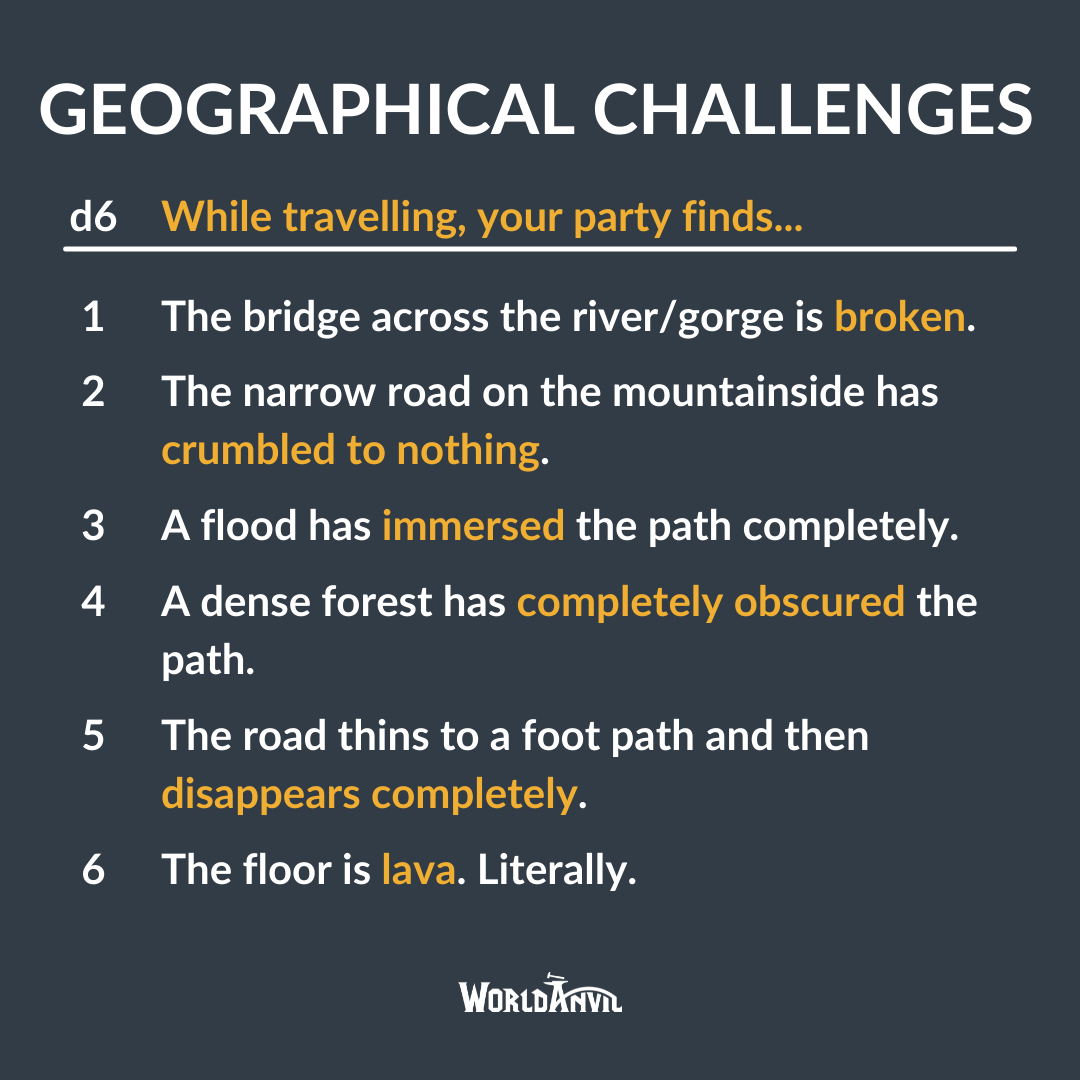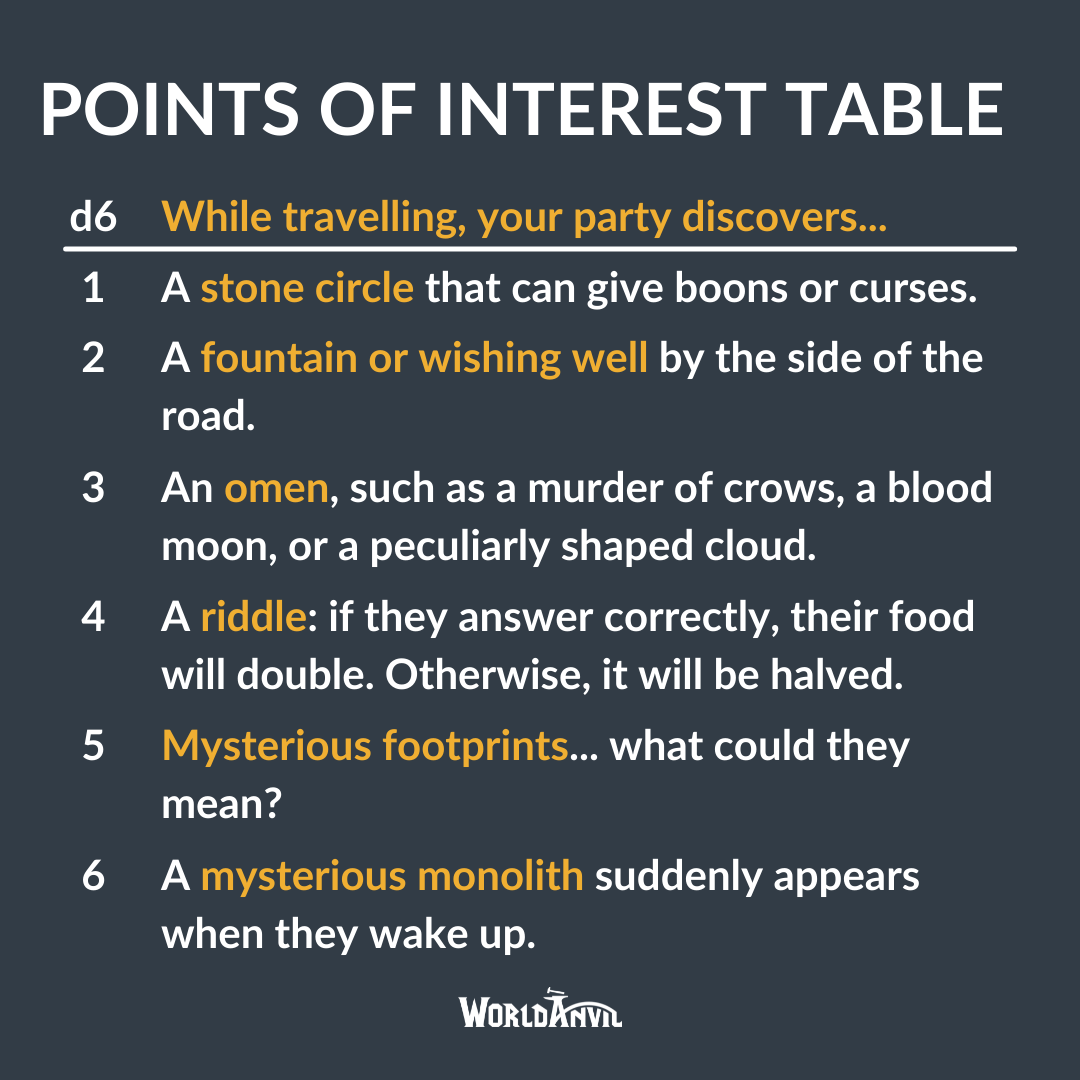Travel is a part of so many campaigns and adventure stories. After all, it’s called the Hero’s Journey for a reason! And making DnD travel interesting is a real challenge. Too often, it either feels so laborious that the party is bored by the time they get there. Or else, it’s so quickly skipped over, that it doesn’t have any impact on the players at all.
5 tips for making DnD travel interesting!
1. Vary the modes of travel
If your players always travel in the same way, it can get pretty boring pretty fast. So, your first step is to give them several options! Maybe they’ll still choose the same familiar mode, but there’s a chance they’ll pick another one. Then, make sure that traveling with a different method changes their travel speed too! You can use the DnD travel speed table as a reference for how far can characters travel on foot in a single day (assuming they walk for 8 hours):
- Slow pace: 18 miles (about 29 km)
- Normal pace: 25 miles (about 38 km)
- Fast pace: 30 miles (about 63 km)
But, of course, other methods of transportation will have different speeds. A ship will be faster, while a carriage might be slower, depending on how heavy it is and how many horses are used to pull it (news flash: horses need to rest too)! So, to sum this section up, give your players clear choices of travel modes that make sense for the location they’re going to, and calculate the travel pace from that!

2. Introduce not-so-random DnD travel encounters (but not Pokemon style!)
Random encounters are a great way to spice up travel—but be careful! They can feel random to the players at first, but make sure to tie them up with the story or the world in some way. Fighting 1d4 wolves just because they were walking in tall grass will feel pointless (and poor wolves, they were just chilling!). So, what should a good “random” encounter include?
- Themes and tone: make sure that the encounter reflects the campaign’s theme and tone. This will make it feel more consistent with the world!
- Link it to the story: sure, you can give them some wolves to fight… and then reveal that they were the pets of an important NPC they’ll meet. Whoops!
- Tactical interest: what will your players get from it? It could be some loot, new information, cool powers…
- A reason to care: why would the players engage with this encounter? Tying them to their backstories, or a cause or NPC they care about. is a sure-fire way to make them engaged.
And remember that encounters don’t have to be only combat: they could meet an NPC, find an ancient ruin, … up to you! As long as the encounter has a goal (other than “being filler”), you’re good to go!
Want more posts like this? Subscribe to the World Anvil blog!
3. Introduce weather and geographical difficulties… with impact
There’s a basic weather table in the DM’s Guide (page 109), but remember that weather changes biome by biome, and the difficulties of the ice wastes are not those of the scorching desert. However, whether they’re ice storms or sand storms, creating days of easier and harder weather can create variation in days of travel. You can challenge the players’ initiative. Are they wise enough to shelter for the day or press on? Will they finally use that magic item they’ve been hoarding? More importantly, will they arrive in a weakened or less-prepared state?
This is something that Cubicle7’s “Adventures in Middle Earth” does very well—it creates difficulties on the journey which can put the players at an advantage or disadvantage when they arrive. This is important, as their prowess in travel then affects the major story arc too. Players may suffer from fatigue, be weakened, or may not have access to all their spells.
Another way to do this, if weather difficulties aren’t appropriate for your setting, are geographical difficulties. Here’s a quick roll table you can use with some ideas and examples.

If the players can’t think of a way to go on, they’ll need to navigate to another path. You can introduce additional difficulties, such as getting lost! This might put unexpected challenges in their way, add additional time to their journey, or introduce them to a nightmare fuelled realm they were initially trying to avoid!
4. Introduce Micro Points of Interest and Scene Pieces!
Remember the non-combat encounters we talked about before? They are a great way to reinforce your world’s genre, tone, and theme (if you don’t know what that is, read about the meta!). To create a good point of interest, follow the four points we talked about for encounters. Otherwise, even if that scene piece is amazing, your players might not be interested in investigating it! Here’s a roll table of 1d6 ideas you can use to start your brain going:

As you can see, these are all pretty genre-agnostic, but also very much open to your interpretation! For example, the riddler could be magic, but maybe they could be a very skilled rogue too. An important part of this kind of encounter is to create a specific atmosphere, so preparing your descriptions in advance might be a good idea if you’re not a master of improvisation! Think about whether you want the events to be creepy, wondrous, mysterious, mystical or even funny, and tailor the details accordingly.
5. Nuke Teleport spells
Sure, magic is cool and all, but what’s the point of going the extra mile to make travel interesting if your party can just teleport wherever they want? Now, that doesn’t mean you have to outright ban all teleport spells from your game—there’s nothing wrong with short-distance teleportation! To prevent long-distance teleporting, you could add external magical elements that prevent teleportation magic from being enabled. For example, cities in your world could have a complex magitech device that creates an anti-magic bubble around them. Or maybe teleportation magic is illegal! Both options add a new layer to your campaign that will not only make travel more fun, but might also come in handy for future plot points.
What are your tips for making DnD travel interesting? Did we miss anything? Let us know in the comments! Getting ready to start a campaign? Send your players our DnD character creator to get them prepped!
Become a World
Anvil member

.png)






.png)
